In wireless communications, the traditional approach is to use various wireless access technologies in accessing the user's “last mile†access network, so that the network provider can quickly cover the network to the hot spots where the user needs. The user can also freely access the communication network without the limitations of the access cable. Although various wireless network technologies are far inferior to the wired transmission technologies in the same period in transmission rate, they provide good technical support for the development of communication networks.
However, with the expansion of the network coverage area, the wired connection requirements of various types of wireless access points make it encounter many challenges and inconveniences in some environments lacking the wired infrastructure. The new wireless network technology - Wireless Mesh Network (WMN) - is gaining increasing popularity due to its unique advantages such as broadband wireless convergence connectivity, effective routing and fault detection, and lack of wired network resources. Much attention. In actual network development, it can be combined with various broadband wireless access technologies such as 802.11, 802.15, 802.16, 802.20, and 3G mobile communications to form a wireless mesh network with multi-hop wireless links. The wireless mesh network can effectively reduce the interference of the fault, reduce the transmitter power, prolong the battery life, and greatly increase the frequency reuse degree, thereby increasing the network capacity, the coverage area of ​​the wireless network, and effectively improving the communication reliability. At present, it has been widely considered in the industry as a development direction of wireless network technology.
2. WMN network structure
In traditional wireless access technologies, point-to-point or point-to-multipoint topology is mainly used. This topology generally has a central node, such as a base station in a mobile communication system, an AP in an 802.11 WLAN, and the like. The central node connects with each wireless terminal through a single-hop wireless link on the one hand, and controls access of the wireless terminals to the wireless network. On the other hand, the central node is connected to the wired backbone network through a wired link and provides a connection to the backbone network.
In wireless Mesh networks, mesh Mesh topology is also a multipoint-to-multipoint network topology. In this Mesh network structure, each network node is connected in a wireless multi-hop manner through adjacent other network nodes. At present, it is generally considered that a wireless mesh network includes two types of network nodes: a Mesh router and a Mesh client.
In addition to the gateway/relay function of the traditional wireless router, the Mesh router also supports the routing function of Mesh network interconnection. A Mesh router usually has multiple wireless interfaces. These wireless interfaces may be constructed based on the same wireless access technology, or may be based on different wireless access technologies. Compared with traditional wireless routers, wireless Mesh routers can achieve the same wireless coverage with lower transmit power through wireless multi-hop communication.
The Mesh terminal also has certain Mesh network interconnection and packet forwarding functions, but generally does not have a gateway bridging function. In general, Mesh terminals have only one wireless interface and the implementation complexity is much smaller than Mesh routers.
According to the different functions of each node, the wireless mesh network structure is divided into three types: backbone network mesh structure (hierarchical structure), client mesh structure (planar structure), and hybrid structure.
2.1 Backbone mesh structure
The backbone Mesh architecture is composed of Mesh routers. It is a self-configured and self-healing network. It is connected to the Internet through the gateway function of the Mesh router. The ordinary client and the existing wireless network can be accessed through the gateway or relay function of the Mesh router. WMN, the network is shown in Figure 1.

Figure 1 Backbone mesh structure
The dashed and solid lines represent wireless and wired connections, respectively. Using a variety of wireless technologies including IEEE 802.11, an ordinary client with an Ethernet interface directly accesses the Mesh router through an Ethernet interface. If an ordinary client adopts the same wireless technology as the Mesh router, communication can be established directly. If different wireless technologies are used, different clients need to first access the base station with the Ethernet interface and then connect with the Mesh router.
2.2 Client Mesh Structure
The client Mesh architecture is composed of Mesh clients and provides point-to-point wireless services between user devices. The client forms a network that can provide routing and configuration functions to support the user's terminal applications. Since the nodes that make up the network do not need to have a gateway or relay function, Mesh routers are not required. The network structure is shown in Figure 2.
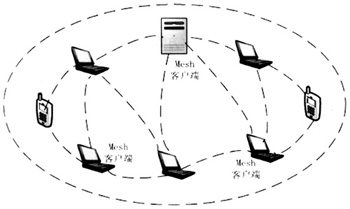
Figure 2 Client Mesh Structure
Clients in this kind of network structure usually use only one kind of wireless technology. Packets sent by any node can be forwarded to the destination node through multiple nodes. Although the nodes do not need the gateway and relay functions, the routing and self-organizing capabilities are necessary.
2.2 Hybrid Structure
Based on the above two structures, a mixed structure is constructed, and the Mesh client can access the backbone Mesh network through the Mesh router, as shown in FIG. 3 . This structure provides connectivity to other network structures such as the Internet, WLAN, WiMax, cellular and sensor networks. In this architecture, the client's routing capabilities can be used to enhance connectivity and expand network coverage for wireless Mesh networks.
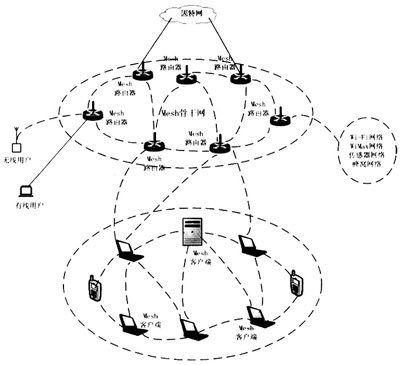
Figure 3 Hybrid Structure
3, WMN network expansion technology
Wireless Mesh networks are the result of the integration of multi-hop technologies with traditional wireless access technologies. For example, after multi-hop technologies are integrated with wireless local area networks (WLANs), wireless personal area networks (WPANs), and wireless broadband metropolitan area networks (WMANs), WLAN-based WMNs, WPAN-based WMNs and WMAN-based WMNs have been created, and ubiquitous access concepts in wireless networks will be fully realized and embodied. However, traditional single-hop network-based protocol mechanisms cannot meet network design or performance requirements, and related technologies such as networking technologies and MAC layer protocols have become hot issues that urgently need to be improved. At the same time, the Industrial Standards Institute (IEEE) is also actively working to establish new standards for wireless mesh networks. The following is a discussion of the networking technology that is of particular interest to the IEEE.
3.1 Network Extension Technology in WLAN
In 1997, the IEEE developed a WLAN standard, the 802.11 protocol, which is mainly used to solve the wireless access between user terminals in office LANs and campus networks. It mainly works in the lowest two layers of the ISO protocol (PHY layer and MAC layer). ). Initially, 802.11 services were mainly limited to data access, and the maximum speed was only 2 Mbit/s, but the subsequent peak rates of 802.11b and 802.11 a/g could reach 11 Mbit/s and 54 Mbit/s, respectively, while the 802.11n in the study The rate can reach 100 Mbit/s. With such rate guarantees, it is possible to abandon traditional cable connections for home, office, campus, and community networks, increase networking flexibility, and reduce the overhead of laying and maintaining networks.
However, the inherent properties of the traditional MAC layer protocol of the 802.11 Ad hoc mode do not support the mesh connection, resulting in poor network performance. To this end, the IEEE established an 802.11 s sub-working group to develop a standardized extended service set (ESS), that is, 802.11 s defines a MAC layer protocol specifically for wireless mesh networks and a network and other protocols based on the MAC layer.
There are two basic structures in the traditional 802.11: the network structure of the infrastructure and the network structure of the terminal equipment. The 802.11 s working group has developed new specifications to support these two structures. The tree multihop WLAN mesh network shown in FIG. 4 is an extension of the network structure of the infrastructure. The network consists of three types of nodes: Mesh nodes (MPs), Mesh access points (MAPs), and traditional WLAN sites. Among them, MP is divided into general MP and root MP. The root MP is an extension of the traditional AP. One end of the root MP is connected to the Internet through wired or wireless connections, and the other end is extended in the form of a spanning tree. A spanning tree has one and only one root MP. It controls the entire network, such as the network topology and link load, and its role is equivalent to a central control device. Due to power limitations, the root MP can only communicate with its child nodes within a single hop range. Similarly, other general MPs of this spanning tree can only communicate with its child nodes and parent nodes within a single hop range. Therefore, if a node in the network that is not within a single hop wants to communicate, it must use the routing protocols proposed in the draft, such as RM-AODV, RM-OLSR, and so on. In order to maintain compatibility with traditional WLAN sites, MAP plays a variety of roles: For a legacy 802.11 site within its transmission range, it can be viewed as an AP; for other MPs, it can be seen as normal. MP.
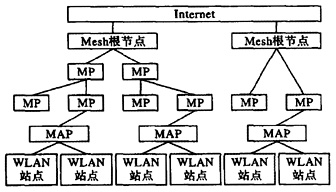
Figure 4 802.11 s draft tree multi-hop WLAN mesh topology
For the network structure of the terminal equipment, the 802.11 s draft defines an Ad hoc multi-hop WLAN mesh network as shown in FIG. 5 as its extension. The network still consists of MPs, MAPs and traditional WLAN sites. The functions of MP and MAP are very similar to the mobile nodes in traditional mobile Ad hoc networks. They can either send data packets generated by this node or forward data packets from other nodes. In addition, each MP and MAP of the network is equal, and there is no central control node in the network. This is the biggest difference from the tree mesh network. Wireless P2P networks are formed between nodes, without any network infrastructure support.
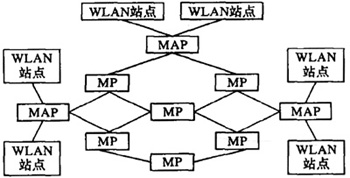
Figure 5 Ad hoc multihop WLAN mesh network topology for 802.11 s draft
3.2 Network Expansion Technology in WPAN
802.15 provides a simple, low-energy wireless connectivity standard that was developed by the IEEE Working Group for WPAN and is developing into a standard for PAN or short-range wireless networks, including portable and mobile computing devices. This standard mainly defines the PHY layer and MAC layer of WPAN. Which is divided into several sub-working groups, the corresponding sub-group and its definition of content comparison shown in Table 1.
Table 1 Definitions of 802.15 subgroups 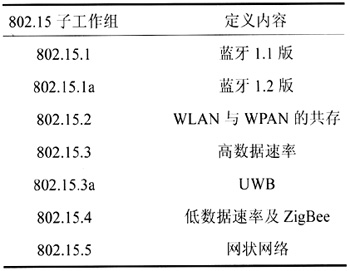
So far, 802.15.1 to 802.15.4 cannot support the mesh network structure directly, but only the piconet structure under the PMP method. However, the scatternet already has the prototype of WMN. The 802.15.5 working group was established at the latest, and the solicitation program began in January 2005. At present, standards are in the process of being formulated. It inherits some of the basic ideas of 802.15.1-802.15.4, but it fully supports mesh structure and mobility management because the standard work has not yet been completed, so the following only focuses on some representative Program.
In the 802.15.5 standard, a mesh network is defined as a PAN in two ways: full mesh topology and partial mesh topology. In a full mesh topology, each node is directly connected to any other node; in some mesh topologies, only some nodes are connected to all other nodes, while other nodes are only connected to nodes that exchange more data. The main issues involved in the standard include: beacon scheduling strategies for collision avoidance, short address allocation algorithms, adoption of RTS/CTS in data transmission, routing algorithms, distributed security issues, energy efficiency operation modes, and mobility for mesh nodes and mesh PANs. Sexual support and so on.
The scheme proposed in the draft agreement adopts a beacon-based scheduling strategy. Assume that the device sequence is related and there is no clear network initialization process. The parent-child relationship between node devices is characterized by association. The neighbors (including the parent and child) that a node can hear are the neighbors of the node. Figure 6 shows an example of a mesh network. Among them, Node 1 (Piconet Controller, PNC) is powered on first, and any node is the node associated with this PAN. The number in the dashed circle indicates the range over which the node transmits the signal. After node 1 is activated, it starts scanning first. If no other associated device is found in its radiation range, it automatically becomes a PNC. Once a node becomes a PNC, it starts sending beacons at the beginning of its superframe. Subsequently, node 2 hears the beacon from the PNC, starts to associate with it, and obtains therefrom the PAN ID (the personal area network ID, the node equipment in one PAN must have the same PAN ID, otherwise it cannot directly communicate), the short address and Other information to determine when to send their own beacons. During the process of listening to beacons by nodes 1 and 2A, the neighbor information in the respective neighbor tables is recorded at the same time. In this way, all node operations are gradually completed.
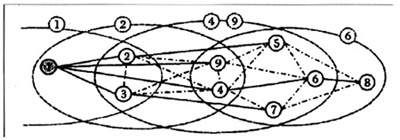
Figure 6 802.11.5 mesh networking process
As shown in FIG. 7 , each mesh device node transmits a beacon during Beacon-Only Period (BOP) to implement beacon scheduling. The solid line between the nodes in FIG. 6 represents the association between the nodes, and the dashed line represents the direct communication capability between the nodes. The correlation strategy is: The new node is associated with the node close to the PNC as much as possible: if the associated node received signal strength (RSSI) is not large enough for reliable communication, the other node is selected as its parent node. Normally, each device must send a beacon signal, but there are exceptions. End node devices (such as node 8) do not have to send beacons to avoid beacon collisions. When more than two PANs are in one area, network consolidation is required. If the solution is not good, it will affect the efficiency of the channel. There are currently some suggestions for this problem, but there is no definite solution.

Figure 7 802.11.5 mesh networking frame structure
From the scheduling-based mesh networking scheme above, it can be seen that the scheme still does not get rid of the central control idea. Compared with the fully distributed idea of ​​the 802.11 s standard draft standard, the applicable application scenario is much more limited.
3.3 Network Expansion Technology in WMAN
On the basis of successfully formulating WLAN standards, the 802 Working Group further developed the WMAN standard according to the demand for broadband wireless Internet access: 802.16d/e, commonly referred to as WiMax. 802.16 defines two network topology structures for the MAC layer: point-to-multipoint (PMP) and mesh networks. The mesh structure is used to solve the coverage problem. Each subscriber unit is part of the network infrastructure and passes multiple hop routes. To achieve full coverage of the network. As shown in Figure 8, the mesh network is controlled by a single central node. This node is defined as a Mesh base station. This node establishes a direct link with the backhaul device outside the mesh network as an interface to the external network.
The standard defines five kinds of management messages for the mesh mode: Mesh configuration message MSH-NCFG: Mesh access message MSH-NENT; Mesh concentration scheduling message MSH-CSCH; Mesh concentration scheduling configuration message MSH-CSCF; Mesh Distributed scheduling message MSH-DSCH. The process of a new node entering the network is as follows: First, the new node searches for MSH-NCFG messages to achieve coarse synchronization with the network. This joining node is called a candidate node. It must select a candidate responsible node from all the neighboring nodes that broadcast the MSH-NCFG message in order to establish a connection to join the network. The candidate node then sends a mesh network access message (MSH-NENT) with a NetEntryRequest (network access request) to this candidate responsible node, and the candidate responsible node evaluates the message, accepts the request and then opens the responsible channel, or rejects the request. If the candidate responsible node accepts this request, the candidate responsible node is said to be the responsible node. Finally, the candidate node needs to pass the authentication into the network, the candidate node sends the authentication information and the authentication request to the responsible node, the responsible node sends the message to the authentication node after being pipelined, and the authentication node verifies the candidate node and judges the candidate node. Can you join the network? After the candidate node enters the network, it registers the node and obtains the Node ID.
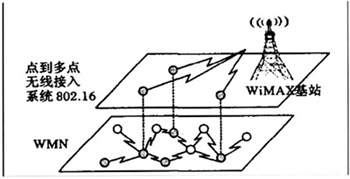
Figure 8 Combination of 802.16 (WiMax) and mesh structure
Through the mesh connection, the Fixed Wireless Broadband Access (FWBA) system originally subject to high-range line-of-sight transmission can achieve double the system capacity. Generally, many gateway nodes in a WMN need an interface that is connected to the backbone network. If an interface such as optical fiber is used for this interface, the network planning will be greatly limited. However, if the FWBA system is used, the gateway node is implemented to the backbone network. The access will be a very effective solution. Figure 9 shows the 802.16 FWBA system structure based on a mesh structure. The four mesh subnets “AirHood†are called “AirHead†base stations respectively, and the base station is connected to a backhaul point. Through this backhaul point, the information is transmitted to the network management system. The server eventually connects to the Internet.
This structure better solves network coverage problems and accommodates multiple user access. Figure 10 shows the quantitative analysis of network capacity enhancement by the mesh network structure. Among them, the coverage rate of M base stations is 1-(1-z)m, and 802.16 (WiMax) has greater coverage than PMP. Obviously, as the number of base stations "AirHead" increases, the network coverage also increases.
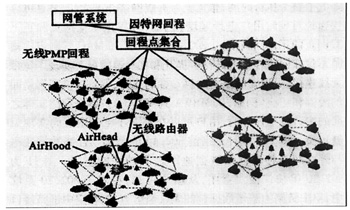
Figure 9 802.16 (WiMax) WBA system based on mesh structure
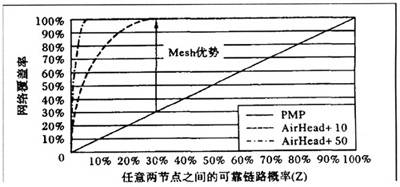
Figure 10 Network coverage of 802.16 (WiMax) mesh structure
4, WMN application prospects
With the development of technology, IEEE802 establishes an IEEE802.11s working group. The purpose of this group is to define MAC and PHY layers for WMNs to improve WLAN coverage and enable it to cover the world. In the new WLAN architecture, the access points (APs) of the WLAN can transmit information to each other through single-hop or multi-hop and automatically form the WMN backbone of the WLAN. As new APs are added, system capacity will increase. In addition, many other IEEE standards working groups (such as 802.15.5, 802.20, and 802.16a) are also introducing WMN technology into the corresponding standards to improve their respective system capacity and information transmission reliability.
The industry also began to pay attention to and study the technology and develop products based on the technology. Existing companies and manufacturers have started to provide the market with solutions for indoor and outdoor environments and have intellectual property (WMN) solutions. Tropos, BelAir and others have already sold 802.11-based products on the market. For example, Tropos's outdoor cellular Wi-Fi network, each Wi-Fi cell is actually a WLAN with routing capabilities. One of Tropos's key technologies is its efficient wireless design that ensures high performance, large area coverage and high throughput. The transmit power of AP up to 1W far exceeds the 100 mW transmit power of ordinary APs, providing greater coverage and ability to penetrate the wall; the receiving sensitivity is 8 dB higher than that of ordinary APs, providing users with higher use bandwidth; dual set antennas Designed to ensure the quality of the received signal. Another key technology is the use of the MetroMesh operating system. The MetroMesh system integrates the industry's most comprehensive network routing intelligence technology to optimize throughput from the bottom up in a Wi-Fi wireless network environment and easily manage thousands of Wi-Fi cells, enabling Wi-Fi deployment in the past Unable to deploy Metropolitan Area Network. Because 802.11 is targeted at fixed, short-range and low-power applications, it does not support mobile and wide-range applications well. Because of this, MeshNetwork developed a technology called Orthogonal Division Multiple Access (QDMA) technology platform, which has the following functions: multi-hop Rake receiver, real-time equalization algorithm, can compensate for the rapid fading of the mobile environment channel.
For WMAN, WiMax technology is a technology that is currently favored by everyone. Its standard is 802.16a/d/e. 802.16a/d has been developed, but it only supports fixed-point access for line-of-sight transmissions, while the 802.16e standard has yet to be determined. It will support non-line-of-sight transmissions with some mobility. In general, WMN has entered the market ahead of WiMax and 3G in terms of market share. At the same time, WMN can also rely on market-accepted Wi-Fi terminals to rapidly develop and already occupy a part of the market. From a technical perspective, WMN, Wi-Fi, and WiMax can complement each other to form a wireless metropolitan area network. Wi-Fi occupies the terminal LAN access market with low cost and popular applications. WiMax can be used as a fixed-point access to metropolitan areas. WMN can implement mobile broadband dedicated communication network in the metropolitan area. Perhaps in the near future, the proposed 802.16e and currently existing mobile broadband wireless access (WBMA) based on the 802.20x standard will have some competition in the application, but due to the difference in specific requirements, the complementarity between them should be Greater than competitive.
In addition, the WMN is introduced into the mobile communication network, and different mobile phone users of the same base station can directly communicate with each other through the wireless Ad Hoc. The base stations controlled by the same switching center also form a wireless base station network through multi-hop wireless connection. In this way, they can effectively reduce the workload of the base station and the switching center on radio resource management and scheduling, and increase the communication speed, efficiency, and reliability of the same base station and different users in the same switching center.
WMN this emerging network not only has a broad application space in wireless broadband access, in other aspects such as combining data, image acquisition module can monitor the target object or data acquisition, and is widely used in environmental detection, industry, transportation and other fields . With the continuous improvement of other technologies, WMNs are better integrated and complementary to each other, so that they can play their respective advantages by taking advantage of weaknesses and avoiding weaknesses.
5. Concluding remarks
The emerging WMN network has a wide application space in wireless broadband access. In wireless mesh network applications, there are three challenges: First, the key technologies of mesh networking; Second, to overcome the deterioration of network performance caused by the rapid movement of nodes; Third, the necessary standardization for large-scale applications. technology. At present, research work on related technologies at home and abroad is quite extensive, and there are products available, but there is still a lack of organic integration of these three aspects. The International Organization for Standardization, in particular the IEEE, is working hard to promote the standardization of wireless mesh networks with the academic community. The mesh networking technology is standardized in standards such as 802.11 s/16d/16e/20/15.5. The protocol layer implements functions such as access control, mesh networking, routing, link congestion control, fast mobility, handover support, and security authentication. However, WMN related technologies are still far from mature, so we need to step up research on its core technologies, such as designing WMN routing algorithms, radio resource scheduling algorithms, and how users can implement handovers between different cells in the backbone network.
XRX using the advanced technology and equipment , manufacturing the best quality fiber connector for all our customers, It is a kind of insert an extraction connector based on the single core plug and adaptor, which both ends of optical cable have the connector plugs, according to the joint can be classified to type SC,FC,LC,ST,MU,MPO,MTRJ,E2000,and so on ,according to difference of the end face have the type PC,UPC,APC and so on. SC stands for Subscriber Connector- a general purpose push/pull style connector. It is a square, snap-in connector latches with a simple push-pull motion and is keyed.
SC Patch Cord,SC SC Patch Cord,SC Fiber Patch Cable,SC Fiber Cable
Chengdu Xinruixin Optical Communication Technology Co.,Ltd , https://www.xrxoptic.com